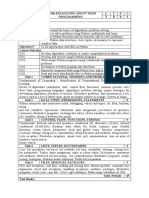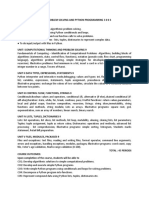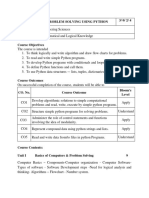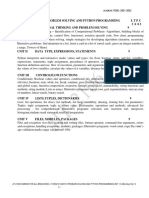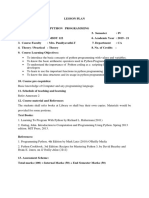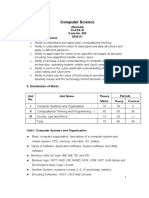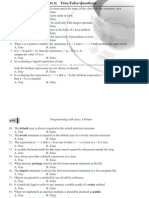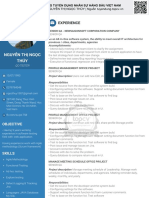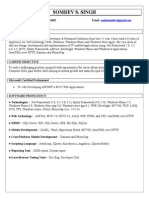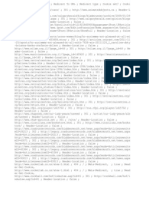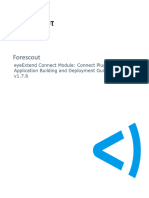DEPARTMENT OF MECHANICAL ENGINEERING
COURSE PLAN-THEORY
Course Code GE3151
Problem Solving and Python
Course Name
Programming
Regulation R2021
Name of the Course Instructor(s) Dr. T.PREMKUMAR
Name of the Course Coordinator Dr. L. SELVAM
Academic Year: 2024-2025
Branch / Year / Semester IT/I/I
Date of Commencement of Class .09.2024
Date of Completion of Class
Revision No 0
Prepared By, Verified By
Dr. T.PREMKUMAR Dr.V.Jeyabalaji
AP/ME HoD/ Mech
Approved By
1
� SYLLABUS
COURSE
COURSE NAME L T P C
CODE
GE3151 PROBLEM SOLVING AND PYTHON PROGRAMMING 3 0 0 3
COURSE OBJECTIVES :
To understand the basics of algorithmic problem solving.
To learn to solve problems using Python conditionals and loops.
To define Python functions and use function calls to solve problems.
To use Python data structures - lists, tuples, dictionaries to represent complex data.
To do input/output with files in Python.
UNIT I COMPUTATIONAL THINKING AND PROBLEM SOLVING 9
Fundamentals of Computing – Identification of Computational Problems -Algorithms, building blocks of
algorithms (statements, state, control flow, functions), notation (pseudo code, flow chart, programming
language), algorithmic problem solving, simple strategies for developing algorithms (iteration,
recursion). Illustrative problems: find minimum in a list, insert a card in a list of sorted cards, guess an
integer number in a range, Towers of Hanoi.
UNIT II DATA TYPES, EXPRESSIONS, STATEMENTS 9
Python interpreter and interactive mode, debugging; values and types: int, float, boolean, string , and list;
variables, expressions, statements, tuple assignment, precedence of operators, comments; Illustrative
programs: exchange the values of two variables, circulate the values of n variables, distance between two
points.
UNIT III CONTROL FLOW, FUNCTIONS, STRINGS 9
Conditionals:Boolean values and operators, conditional (if), alternative (if-else),chained conditional (if-
elif-else);Iteration: state, while, for, break, continue, pass; Fruitful functions: return values, parameters,
local and global scope, function composition, recursion; Strings: string slices, immutability, string
functions and methods, string module; Lists as arrays. Illustrative programs: square root, gcd,
exponentiation, sum an array of numbers, linear search, binary search.
UNIT IV LISTS, TUPLES, DICTIONARIES 9
Lists: list operations, list slices, list methods, list loop, mutability, aliasing, cloning lists, list parameters;
Tuples: tuple assignment, tuple as return value; Dictionaries: operations and methods; advanced list
processing - list comprehension; Illustrative programs: simple sorting, histogram, Students marks
statement, Retail bill preparation.
UNIT V FILES, MODULES, PACKAGES 9
Files and exceptions: text files, reading and writing files, format operator; command line arguments,
errors and exceptions, handling exceptions, modules, packages; Illustrative programs: word count, copy
file, Voter’s age validation, Marks range validation (0-100)
TOTAL: 45 Periods
CONTENT BEYOND SYLLABI:
Network Communications
COURSE OUTCOMES:
After the successful completion of this course, the student will be able to
CO1: Develop algorithmic solutions to simple computational problems.
CO2: Develop and execute simple Python programs.
CO3: Write simple Python programs using conditionals and loops for solving problems.
CO4: Decompose a Python program into functions.
2
� CO5: Represent compound data using Python lists, tuples, dictionaries etc. CO6: Read and write
data from/to files in Pyt hon programs.
TEXT BOOKS:
T1. Allen B. Downey, “Think Python: How to Think like a Computer Scientist”, 2nd Edition,
O’Reilly Publishers, 2016.
T2. Karl Beecher, “Computational Thinking: A Beginner's Guide to Problem Solving and
Programming”, 1st Edition, BCS Learning & Development Limited, 2017.
REFERENCE BOOKS/LINKS:
R1. Paul Deitel and Harvey Deitel, “Python for Programmers”, Pearson Education, 1st Edition,
2021.
R2. G Venkatesh and Madhavan Mukund, “Computational Thinking: A Primer for
Programmers
and Data Scientists”, 1st Edition, Notion Press, 2021.
R3. John V Guttag, "Introduction to Computation and Programming Using Python: With
Applications to Computational Modeling and Understanding Data”, Third Edition, MIT
Press, 2021.
R4. Eric Matthes, “Python Crash Course, A Hands - on Project Based Introduction to
Programming”, 2nd Edition, No Starch Press, 2019.
R5. https://www.python.org/
R6. Martin C. Brown, “Python: The Complete Reference”, 4th Edition, Mc-Graw Hill, 2018.
R7. Reema Thareja, “Python Programming: Using Problem solving Approach”, 1st Edition,
Oxford University Press, India, 2017.
PLAN OF DELIVERY
Cum
Ref. ulativ Teaching
Sl. Page Hour Teachin
Topic Covered Book e Methodolog
No No s g Aid
Code Hour y (If any)
s
UNIT-I :COMPUTATIONAL THINKING AND PROBLEM SOLVING
L-9
Fundamentals of Computing -
31-
1. Identification R7 1 1 BB -
32
of Computational Problems
Algorithms, building blocks of
32-
2. algorithms (statements, state, R7 1 2
36
control flow, functions) BB -
Notation (pseudo code, flow 37- Think Pair
3. R7 1 3
chart, programming language) 41 BB Share
4. R7 33- 1 4 LCD+
Algorithmic problem solving 34; BB
3
� Cum
Ref. ulativ Teaching
Sl. Page Hour Teachin
Topic Covered Book e Methodolog
No No s g Aid
Code Hour y (If any)
s
1.1- -
T2 3.9
Simple strategies for PPT
35-
5. developing algorithms R7 1 5
36
(iteration, recursion)
Illustrative problems: find Think Pair
240-
6. minimum in a list, insert a card R7 2 7 BB Share
244
in a list of sorted cards,
Guess an integer number in a 239-
7. R7 2 9 LCD+ -
range, Towers of Hanoi 241
BB
UNIT-II :DATA TYPES, EXPRESSIONS, STATEMENTS
L-9
Python interpreter and 14- LCD
interactive mode, Debugging T1
15;
8. 1 10 -
87-
R7
88
Values and types: int, float, 11- BB
boolean, string, and list T1 12;
9. 1 11 -
94-
R7 97
BB
12-
T1
14
10. Variables, expressions 1 12 -
94-
R7
97
114- BB Think Pair
11. Statements, tuple assignment T1 2 14
116 Share
15- LCD+
T1 BB
precedence of operators, 18 Think Pair
12. 2 16
comments 105- Share
R7
109
Illustrative programs: exchange
the values of two variables,
Think Pair
13. circulate the values of n R5 NA 2 18
Share
variables, distance between two
points
UNIT-III :CONTROL FLOW, FUNCTIONS, STRINGS
L-9
Conditionals: Boolean
T1; 39-
values and operators
R7 40 LCD+ Think Pair
14. 1 19
BB Share
103-
R7
105
Conditional (if), alternative (if- 42- LCD+
15. T1 1 20 -
else), chained conditional (if- 43; BB
4
� Cum
Ref. ulativ Teaching
Sl. Page Hour Teachin
Topic Covered Book e Methodolog
No No s g Aid
Code Hour y (If any)
s
elif-else) 138-
R7
142 ;
97-
R1
102
Iteration: state, while, for, 102-
break, continue, pass R1
104 LCD+
16. 1 21 -
33- BB
R3
41
Fruitful functions: return T1 51-
values, parameters, local and 55; LCD+
17. global scope, 1 22 -
R7 185- BB
201
Function composition, T1 55-
recursion 60; LCD+
18. 1 23 -
R7 211- BB
216
Strings: string slices, T1 72-
immutability, string functions 75; Think Pair
19. and methods, string module 1 24 BB
R7 242- Share
271
Lists as arrays 196-
20. 1 25 LCD -
R2 203
Illustrative programs:
square root, gcd,
Think Pair
21. exponentiation, sum an array of R5 RA 2 27 BB
Share
numbers, linear search, binary
search
UNIT-IV : LISTS, TUPLES, DICTIONARIES
L-9
87- LCD+ -
T1 BB
89;
22.Lists: list operations, list slices 1 28
322-
R7
325
90- LCD+ Think Pair
List methods, list loop, T1 BB Share
94;
23.mutability, aliasing, cloning 2 30
lists, list parameters 326-
R7
335
Tuples: tuple assignment, tuple 94- LCD+ Think Pair
24. T1 2 32
as return value 96 BB Share
Dictionaries: operations and R4 95- LCD+ -
25. 1 33
methods 115 BB
Advanced list processing - list T1 91- LCD+ -
26. 1 34
comprehension 92 BB
5
� Cum
Ref. ulativ Teaching
Sl. Page Hour Teachin
Topic Covered Book e Methodolog
No No s g Aid
Code Hour y (If any)
s
Illustrative programs: simple R5 LCD+ Think Pair
sorting, histogram, Students BB Share
27. RA 2 36
marks statement, Retail bill
preparation.
UNIT-V : FILES, MODULES, PACKAGES
L-9
T1 133- -
137;
28. Files and exceptions 1 37 BB
R7 289-
295
T1 343- BB -
Text files, reading and writing 354;
29. 2 39
files R7 431-
433
T1 138- BB -
Format operator, command 139;
30. 1 40
line arguments R4 438-
441
T1; 140- BB -
Errors and exceptions, handling R6 141;
31. 1 41
exceptions 125-
148
T1 143- BB -
32. Modules, packages 2 43
145
Illustrative programs: word 217- LCD+ Think Pair
count, copy file, Voter’s age R7 237 BB Share
33. 2 45
validation, Marks range
validation (0-100)
Content Beyond Syllabus
Network Communications R5 NA PPT+B -
34. 1 46
B
ASSESSMENT PLAN
ASSESSMENT SCHEDULE-TEST
TEST DATE
TEST PORTION FOR TEST
NO. PLANNED CONDUCTED
UNIT-I and UNIT II
Internal I
Assessment
UNIT III and UNIT-IV
Test II
UNIT-I
I
Class Test
UNIT III
II
Model Exam I Unit to V Unit
I
6
� ASSESSMENT SCHEDULE-ASSIGNMENT
Group Date of Submission
Assignment No Mode
/Common/Individual
I Written Group
II Seminar Individual
III Online Common
ASSESSMENT PATTERN
ITEM WEIGHTAGE
Continuous Assessment-I 40
Internal Assessment Test – I 60
40
Continuous Assessment-II 40
Internal Assessment Test – II 60
End Semester Examination 60
Total 100













